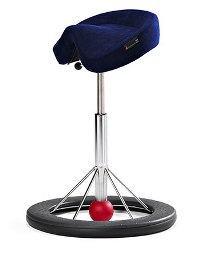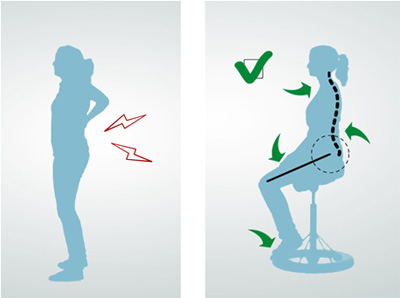Back App Ergonomic Office Chair Review
Like most reviews sites, our editorial staff and laboratory testing expenses are partially offset by earning small commissions (at no cost to you) when you purchase something through those links. Learn More

Overview
| Review Summary |
Already a hit in Europe, the Back App is making its way across the pond to challenge the Muvman and Mobis in America. Its sleek aesthetic and elegant design make this active chair a heavy contender, and earned it our coveted five star rating. |
|---|---|
| Where to buy |
Buy on Amazon |
Rating
| Stability | |
|---|---|
| Safety | |
| Reliability | |
| Quality and Aesthetics | |
| Ergonomics | |
| Innovation | |
| Positives | The Back App is comfortable enough to support you on your necessary sitting breaks, but not so comfortable that you'll end up spending too much time sitting - or worse, sitting with a bad posture. The chair's wobble ball does a great job of keeping your back and stomach muscles active, the specially-contoured seat encourages your pelvis and spine into an ideal posture, and the snazzy aesthetics would look good in most any office. |
| Negatives | The Back App starts at a price a little higher than other chairs, but in this case, it is a classic example of getting what you pay for. |
Bottom Line
[Editor’s Note: The original Back App chair has been discontinued in America. The new model, Back App 2.0, is a significant upgrade over the first. For more details, read our Back App 2.0 Review. For posterity, this page will remain on our website]
America is going through a Renaissance in active office furniture. Standing desks, treadmill desks, desktop risers, and adjustable-height conference tables are all slowly transforming the workplace for the better. And as our desks change, so too do our chairs. With mounting evidence warning of the dangers of too much sitting, there is a growing campaign to reduce the amount of time office workers spend in their chairs.
But let’s face it: you can’t completely get rid of office chairs. It’s not realistic, and it’s not even healthy. While excessive sitting seems endemic to modern American life, too much standing carries its own problems: fatigue, varicose veins, and the risk of deep vein thrombosis. What’s needed in contemporary offices isn’t a total rejection of chairs but balance, wherein workers are regularly switching between sitting, standing, and walking. And to that end it’s important that workers get the most movement and ergonomic benefits from all of their workstation configurations.

Enter the Back App. The Swedish active chair is a heavy contender in the European market, most notably winning the Award for Design Excellence by the Norwegian Design Council in 2007. In fact, according to Dr. Sean Mandel and Dr. Todd Comer, the two Pennsylvania chiropractors responsible for getting Back App into the US market, some 50,000 of these chairs have already been sold in Europe. After our reviews of the category-defining Muvman, the new Focal Upright Mobis, the Bimos Fin, the Varier Move, and other $500-$600 active chairs, we’ll admit to some skepticism upon encountering yet another, even more expensive iteration of the theme (the Back App starts at $695). We spent a few weeks really putting the Back App through its paces to find out how it stacks up against the competition.
A Quick Lesson in Active Chair Ergonomics
The key to all the new “active” chairs (or stools, whichever term you prefer) entering the market is the ability to stimulate core postural muscles in a smooth and controlled manner. Experts argue that humans were not designed to sit with their upper legs at a 90 angle to the spine for prolonged periods of time. Indeed lower back pain induced by too many years of too many hours sitting in office chairs, cars, restaurants and sofas has been the leading driver of interest in sit-to-stand desks and treadmill desks. Active chairs help remedy the deleterious effects of traditional chairs by increasing the hip angle or allowing one to sit higher. Doing this lets one support the low back curve, thereby reducing stress on the spine.

Saddling Up to Better Posture
The Back App sports a unique form. A comfortably cushioned saddle seat perches on a metal column attached to a footrest ring (well padded underneath). But what sets the Back App apart from other chairs is the round ball attached to the bottom of the center column. With a quick spin in one direction or the other, the ball allows you to adjust the height of the center column relative to the footrest ring, lifting the Back App and putting it into an intentionally unbalanced position. This off-kilter chair angle is what gives the Back App its movement capability. It forces the user to address his or her posture constantly in order to remain balanced. This constant movement creates proper ergonomic comfort for the user’s back, and strengthens the muscles that surround the spine. It’s an impressive approach to creating a variable degree of movement that has some distinct advantages over other designs we’ve tested in the lab.
Setting up the Back App is a bit of a process for first-time users, but the immediate payoff is big. You start by adjusting it to your desired level of imbalance, by twisting the aforementioned red ball. Next, you have to adjust the height of the chair: with you seated as far back as the edge of the chair allows, the contours of the saddle seat should form around your legs and the balls of your feet should rest gingerly on the foot pad. The Back App can be adjusted anywhere between about 25” and 35” high – tall enough to comfortably seat most users. A ‘Low Lift’ model (about 22″-28″ high) is also available for users who are less than 5’2” tall. Heavier users should beware: the Back App – which in all its advertisement employs slender Scandinavian women – is rated up to 250 lbs.
The experience of sitting on the Back App is surprisingly pleasant. The saddle seat has ample room for most users, with a generous amount of cushion to keep you perched comfortably. To allow your legs to reach the foot pad, the seat slopes down comfortably. The seat is made from a soft Nordic Wool. If that’s not your style the Back App comes in four colors of Alcantara – a new, suede-like material previously reserved for haute couture fashion and high-end sports cars like the Lamborghini Gallardo. The foot pad is sufficiently cushioned against the floor as well, providing some much-needed shock-absorption while you’re swaying around.
And sway you will, if you have the balance set to ‘fairly wobbly’ like most of us at the testing lab did. Natural fidgeters will feel right at home with the Back App’s constant motion. Some users however will experience a slight discombobulating feeling when they first seat themselves on the Back App. It’s a chair that, if configured properly, will constantly fight your attempts at sitting comfortably. We’ve noticed that any bit of slouching (a likely consequence of sitting for most people) will cause the Back App to tilt backwards away from the table. It forces users to keep their center of balance in a straight line by keeping their posture in check. If you find yourself frequently correcting your posture then you know the device is working, and you’re on your way to a straighter stature.
The constant movement required to properly sit engages the user’s back muscles, core muscles, and legs. The 360 degrees of hip movement also help prevent the dreaded lower back stiffness normally associated with standard office chairs. This in turn goes a long way to staving off fatigue, and testers found themselves with more energy after sitting on a Back App compared to sitting on a regular office chair. This is one aspect of active sitting where the Back App chair seems to sail past the competition. While all the others offer active motion, only the Back App firmly positions the pelvis so that your sitting posture is always ideal. This feature alone could justify the slightly higher cost of this chair compared to the Muvman and Mobis.
Back Apps in the Moving Workplace
 For the maximum benefit and greatest comfort, you’re going to want to mate the Back App with an adjustable-height desk. Not only will this give you the option of mixing standing in with active sitting, it will allow you to use the Back App at different heights at different times. Some of our testers found that there isn’t just one sweet spot setting for the chair height, as there supposedly is for those fancy ergonomic office chairs with 17-lever adjustability. Sitting at different heights reduces fatigue and keeps you more energized throughout the day. Pairing a height-adjustable desk with an active chair is definitely a case where the end result is greater than the sum of its parts.
For the maximum benefit and greatest comfort, you’re going to want to mate the Back App with an adjustable-height desk. Not only will this give you the option of mixing standing in with active sitting, it will allow you to use the Back App at different heights at different times. Some of our testers found that there isn’t just one sweet spot setting for the chair height, as there supposedly is for those fancy ergonomic office chairs with 17-lever adjustability. Sitting at different heights reduces fatigue and keeps you more energized throughout the day. Pairing a height-adjustable desk with an active chair is definitely a case where the end result is greater than the sum of its parts.
The flexibility of the Back App also makes it the best partner for adjustable height conference tables we’ve seen. If you’re going to take the enlightened step of providing sit-to-stand conference tables for your employees (and you should), pairing those tables with active chairs that can be used at any table height is better ergonomically as well as aesthetically, and it’ll obviate any complaints you might get from employees who’d rather die than get off their duffs.
A New Category Leader
As we said, we went into this review with skepticism, not expecting to be impressed. The Back App has become the new staff favorite and earns our Experts Pick designation along with an uncommon 5-star rating. While it may take a few hours of use to get comfortable with the settings and the new back posture, within days users are sure to fall in love with the Back App, and never want to switch back to the chairs that gave them lower back pain, stiff muscles, slouching posture and circulatory problems. Is the extra $100 or $200 above the price of the Mobis or Muvman worth it? We’ve tried them all extensively and have to say this is a classic case of “you get what you paid for, and you pay for what you get.” If you can spring for it, we highly recommend it.

0 Comments
Leave a response >